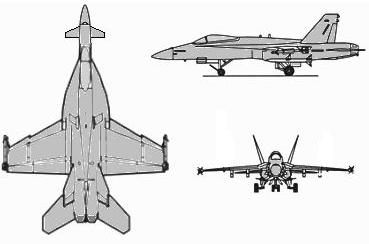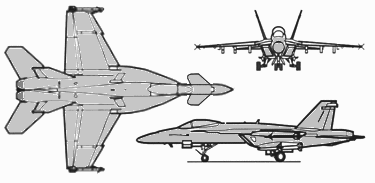


F/A-18 Hornet Series



F/A-18 Hornet Series
 A Tirol Aero-Space Stike Hornet Trainer. |  An Earth Defense Force Navy "Blue Angel" Demonstrator Black Hornet. |
 An F/A-18 Supra Hornet Fighter/Attack |  An F/R/A-18 Black Hornet Fighter/Reconnaissance/Attack. |
| * Fuselage- ** Cockpit- *** Variable Rear Thrusters (2)- *** Wings (2)- *** Tailerons (2)- *** Tail Rudder- *** Tail Rudder- | 250 250 100 each 150 each 60 each 60 60 | *** Grav Pods (3)- *** Forward Canards (2)- MRM Launcher Pods (2)- Landing Gears (3)- Auto Cannon- Air Intakes (2)- | 150 30 100 each 20 each 100 |
Notes:
Speed and Statistical Data: Weapons Systems: 2. Fixed Forward Mini-Missile Rail Launcher: Mini-Missiles fired from the rail launcher either quadruple their range OR triple it and gain +2 to strike. Only Plasma or Hi-Ex MM's can be used. 3. MRM Launchers (2): Where the air intakes USED to be are now a pair of MRM launchers. 4. Internal SRM Launchers (2): The aircraft carries SRM's in internal launcher racks for defensive anti-missile purposes. Features:Taxiing on the ground: 10 MPH
Range On Land: About 1 mile normally; 10 miles max.
Flying: Mach 5
Service Ceiling : 100 miles
Range in the air: 8,000 miles. Can be refueled in the air.
Height: 16 feet
Width: 45 feet
Length: 60 feet
Weight: 33 tonesCargo: Pilot's emergency gear only. All pilots must wear power armor when flying.
Power System: Twin Dual-Phase Aeration JES-12 Hydro-Cell Scramjet Engines.
Flight Systems:
Primary: Grav Pods
Secondary: Normal Aero-Foil effect and Hydro-Cell Jets.
Cost and Availability: 12 million credits each; Every 3 months another batch of 10 becomes available.
Black Market Cost and Availability : An equivalent system would cost1. Fixed Forward Hyper Velocity Autocannon: Fixed forward, this is a limited-purpose dogfighting gun.
Purpose: Anti-Aircraft
MD: 1D4X10 per 40 round burst (can only fire bursts).
Range: 4,000 feet
Rate of Fire: Per pilot's attacks per melee.
Payload: 100,000 rounds (that's 2,500 bursts). Reloading takes 1 minute (4 melees) and requires proper tools.
Primary Purpose: Anti-Aircraft
Secondary Purpose: Ground Attack
Damage and Range: Varies by type.
Rate Of Fire: Per pilots attacks per melee.
Payload: 2,000
Purpose: Anti-Ship/Aircraft
MD and Range: Varies by type used.
Rate of Fire: Volleys of 1, 5, or 10 per pilots attacks per melee.
Payload: Each launcher has 3 stacks of 5 each, for a total of 30.
Primary Purpose: Anti-LRM.
Secondary Purpose: Anti-Aircraft
Damage: Varies by type used.
Rate Of Fire: Volleys of 1, 2, 3, or 4 times pilots attacks per melee.
Effective Range: Varies by type used.
Payload: 12 per launcher (2 launchers).5. Wing Mounted Weapons Systems: The Supra-Hornet can carry up to 6 pods. 7 Rocket Launcher: 24 2-inch rocket tubes in 12 rows of 4 each. Each rocket tube has 4 rockets.
Purpose: Heavy Assault
MD: Each rocket does 2D6 MD
Rate of Fire: Volleys of 6 or 12 times pilots attacks per melee.
Range: 12,000 feet
Payload: 96 per pod. Up to 6 pods can be carried.
Purpose: Offensive/Anti-Ship
MD: 4D6X10 per torpedo
Blast Radius: 40 feet
Maximum Range: 80 miles
Minimum Range: 5 miles
Rate of Fire: 1 torpedo per pilots attacks per melee.
Payload: Each pod holds 3 Mk-82's.
Primary Purpose: Anti-Aircraft
Secondary Purpose: Anti-LRM.
Damage: Varies by type used.
Rate Of Fire: Volleys of 1, 2, 3, or 4 per pilots attacks per melee.
Effective Range: Varies by type used.
Payload: 32 (4 per launcher, 6 pods per wing).
Effect: While active, enemy radar will have a "wash" effect, where a large, highly unstable cloud of radar paint will appear. An experienced (5th level and above) radar operator can SOMETIMES use the flow of the wash to narrow down the source of the jamming, but typically this does little good. NOTE: This IS a form of radar signal, and can therefore by tracked by some ESM systems (-10%).7 pod, used to drop highly sensitive and extensive messages. A nose-mounted device using GPS or laser detection guides the pod to within ¨ûth of an inch of the intended target.
Optic Systems: | Effect: Duration: 1D4 melee rounds. Payload: 60 chaff/flares. Each time the system is engaged, the system fires off 04 chaff/flares. Effects: The decoy has a 98% chance of fooling ordinary non military radars and non smart guided missiles, and a 90% chance of fooling military grade radars and advanced smart missiles. |


